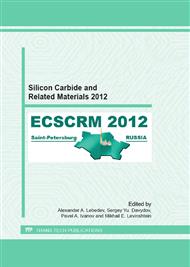p.677
p.683
p.687
p.691
p.695
p.699
p.703
p.707
p.711
Effect of Interfacial Localization of Phosphorus on Electrical Properties and Reliability of 4H-SiC MOS Devices
Abstract:
Metal-oxide-semiconductor (MOS) capacitors with phosphorus localized near the SiO2/SiC interface were fabricated on 4H-SiC by direct POCl3 treatment followed by SiO2 deposition. Post-deposition annealing (PDA) temperature affected MOS device properties and phosphorus distribution in the oxide. The sample with PDA at 800 °C showed narrow phosphorus-doped oxide region, resulting in low interface state density near the conduction band edge and small flatband voltage shift after FN injection. The interfacial localization of phosphorus improved both interface properties and reliability of 4H-SiC MOS devices.
Info:
Periodical:
Pages:
695-698
Citation:
Online since:
January 2013
Authors:
Keywords:
Price:
Сopyright:
© 2013 Trans Tech Publications Ltd. All Rights Reserved
Share:
Citation:


